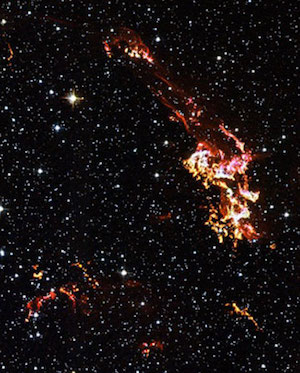It's a Star! It's a Nova!
It's Super-Nova!

Image credit: NASA, ESA, The Hubble Heritage Team (STScI/AURA)
Kepler supernova remnant imaged by the Hubble Space Telescope.
There's more than one sort of "new" star in the heavens, say astronomers. The evidence has been building for decades that novae – those stars which light up suddenly to great brightness, then fade away – actually come in at least two distinct classes. On one hand there are ordinary novae and on the other there are truly Super-Novae.
The first clue that super-novae were lurking among the stars came 35 years ago. This clue was found by Edwin Hubble who died recently. Using his revolutionary method for measuring distances in space, he calculated that a nova observed in 1885 in the Andromeda Galaxy actually must have been about one hundred times more luminous (that is, brighter) than any nova recently observed in our own Milky Way Galaxy.
Fourteen years later in 1934, physicists Walter Baade and Fritz Zwicky used the term "super-nova" when they suggested these were not only far brighter than normal nova, but rare events in any given galaxy. They believed the most recent super-novae in our own galaxy were those recorded by astronomer Johannes Kepler in 1604 and another seen by Danish astronomer Tycho Brahe in 1572.
A new observation was added in 1941 by astronomer Rudolph Minkowski. He split the light from 14 distant super-novae into their component colors and found that nine of these spectra contained no lines for hydrogen and five did. Super-novae without hydrogen lines are called Type I; super-novae with hydrogen lines are called Type II. The possible reason for this, speculates British astronomer Fred Hoyle, is that in the extreme violence of their "death", the giant stars that become supernovae might be capable of fusing hydrogen and helium to make heavier elements like carbon and iron. They are then not only Super, but actually Stars of Steel. •



